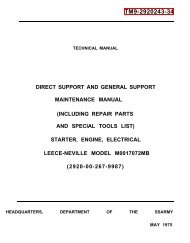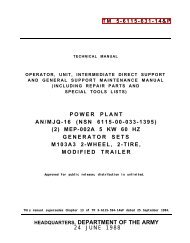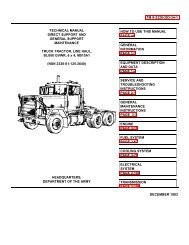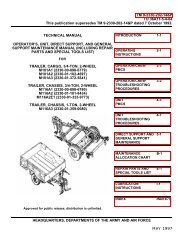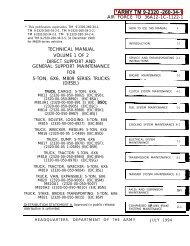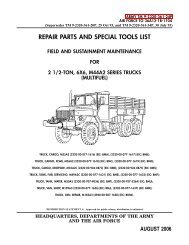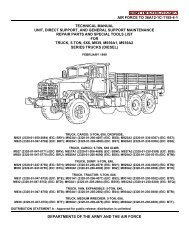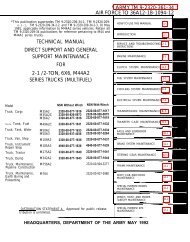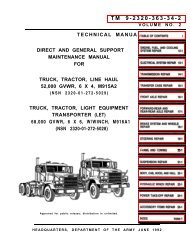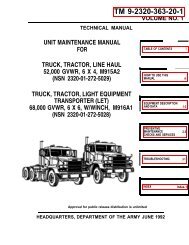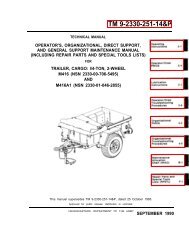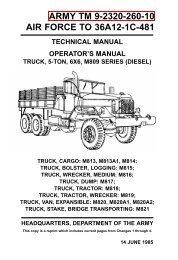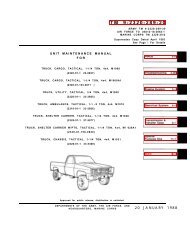TM 9-2320-289-10.pdf
TM 9-2320-289-10.pdf
TM 9-2320-289-10.pdf
Create successful ePaper yourself
Turn your PDF publications into a flip-book with our unique Google optimized e-Paper software.
<strong>TM</strong> 9-<strong>2320</strong>-<strong>289</strong>-10<br />
b. Air Conditioning Unit The air conditioning unit (5) cools end ventilates the ambulance<br />
patient compartment. It is mounted on the front wall of the patient compartment, and is designed<br />
to provide a section between cooling and recirculating inside air and cooling outside air. The inside<br />
air section is used when maximum cooling is required under conditions of high temperature and<br />
humidity. The outside air is used for most air conditioning situations and for vent mode. Fan speed<br />
end temperature may be varied as required.<br />
c. Personnal Heater. Because the heater in the cab is not sufficient to heat the patient<br />
compartment, e personnel heater is provided within the patiant compartment. It produces heat by<br />
burning a mixture of fuel and air in a stainless steel heat exchanger and burner assembly. The heater<br />
is designed to bum fuel from the trucks fuel tank. It can be manually controlled from a control unit<br />
(6) located at the base of the lower litter berth on the right side of the patient compartment.<br />
d. Domelight and Focus Lights. There is a fluorescent domelight (2) over the canter aisle of<br />
the patient compartment to provide light for medical purposes. When the service lights/blackout<br />
toggle switch the ‘“BLACKOUT” position and the rear doors or door between the cab and patient<br />
compartment is open. the domelight goes off and a blackout light (3) comes on. When more light<br />
is needed, four focus lights (1) (two on each wall) can be used. The lights can be pulled from thair<br />
wall mounts and mounted in any of six mounting blocks, or they can be hand held if needed.<br />
1-18. TRUCK LOADING<br />
a. Proper loading of the truck is governed by weight limits and load distribution. The trucks<br />
era rated in tame of Gross Vehicle Weight Rating (GVWR) and Gross Axle Weight Rating (GAWR).<br />
These ratings are beead upon the weekest component in the suspension system (axles, springs, tires,<br />
or wheels.<br />
(1) Gross Vehicle Weight Rating (GVWR). The Gross Vehicle Waight Rating (GVWR) is<br />
the maximum allowable loaded weight of the truck, driver, passenger(s), and payload,<br />
measured in pounds. Tha rating takes into account the capabilities of the engine,<br />
trarsmission, frame, springs, brakes, axles, and tires.<br />
(2) Gross Axle Welght Rating (GAWR). The maximum load that can be put on front and<br />
rear axles.<br />
b. A certification Iabel, located on the trailing edge of the operator’s left-hand door, specifies<br />
these ratings and shows the maximum waight that the front axle can carry (front GAWR) and tha<br />
maximum weight that the rear axle can carry (rear GAWR).<br />
C. The example below shows a fully loaded truck, tha maximum GVWR (1), tha front GAWR<br />
(3), and the back GAWR (2).<br />
Curb weight equals the weight of the truck without driver, passenger or cargo, but includes fuel and coolant.<br />
EXAMPLE ONLY<br />
TA466576<br />
Change 5 1-19



